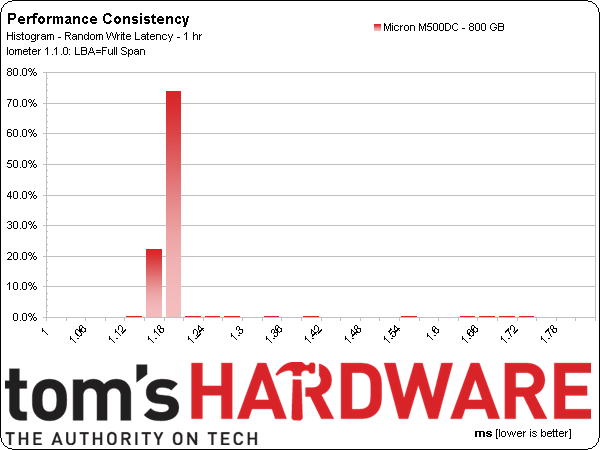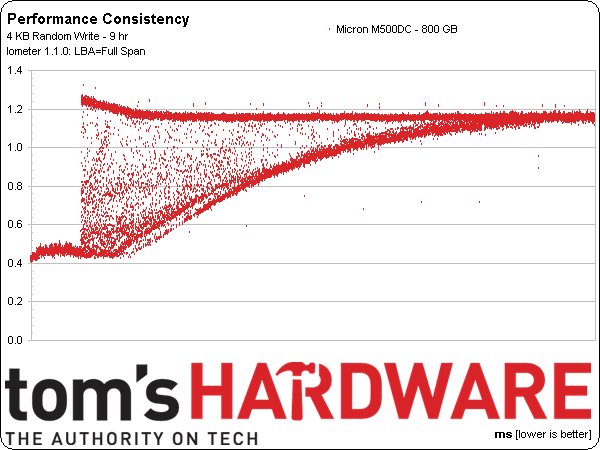Micron M500DC 800 GB SSD Review: Cloud And Web 2.0 Storage
Building on the desktop-oriented M500, Micron is announcing its enterprise-focused M500DC. We got a chance to run the 800 GB model through an updated test suite to gauge whether this Marvell-powered SSD keeps up with the best-known enterprise solutions.
Results: Performance Consistency
Increasingly, we pay close attention to the performance consistency of enterprise-class SSDs. This is what separates a good drive from a great one when all of the corner case testing appears equal. Viewing the data with more granularity gives us insight on particular drive behaviors.
For the following tests, we subject Micron's M500DC and three comparison SSDs to 25 hours of continuous random 4 KB writes. We record IOPS every second, giving us 90,000 data points. We then zoom in to the last 60 minutes to more coherently visualize the results.
Overall, the M500DC performs well, even against more expensive drives. In fact, the M500DC substantially reduces the halo that we observed on Micron's P400m, though it can't quite match the tighter grouping delivered by SanDisk and Intel.
Looking at the distribution of data points reveals another interesting behavior.
Almost 96% of all data points are within 0.06 ms of each other, which is astounding. In comparison, SanDisk's Optimus Eco did not have any 0.06 ms-band that contained more than 58% of its data points. Really, our only complaint is the outliers around the 1.7 ms mark. Still though Micron's M500DC maintains its rated specification on nearly 98% of our measured data points. Even the outliers are at a respectable 18,000 IOPS.
Normally, we only post consistency data on a drive once it reaches steady-state. With the M500DC, getting to this point was more difficult than usual. The chart below shows a fresh M500DC with our random write workload applied.
It took nearly nine hours before the drive finally hit steady-state. We also found that if you aren't careful, the drive will trigger the TRIM command, and you get back to fresh out-of-box performance in a hurry. For what it's worth, only enterprise SSD reviewers get upset when a drive recovers its speed like this. And in case you're wondering, that stretch of data at the beginning lasts for almost an hour, with IOPS ranging from 66,000 to 78,000!
Get Tom's Hardware's best news and in-depth reviews, straight to your inbox.
Current page: Results: Performance Consistency
Prev Page Results: 4 KB Random Performance And Latency Next Page Results: Enterprise Workload Performance-
ParrLeyne Good article/review!Reply
Only one _small_ problem. According to the Micron product page (http://www.micron.com/products/solid-state-storage/enterprise-sata-ssd/m500dc-enterprise-sata-ssd) the M500DC is a SATA device, not SAS! -
tripleX The author obviously does not understand the subject matter. SAS lumped in with SATA? read-centric SSD isnt meant for read workloads? etc. numerous errors, too many to list.Reply -
tripleX Author does not understand what "corner case" is. corner case testing? are you doing lab validation work?Reply -
drewriley In SSD testing, it is common to call the mix in testing between read/write and random/sequential as '4 corner' or 'corner case' testing. And yes, this is lab verification work, that is kind of the point of the review. Also, SAS and SATA do compete for applications. The point was to put different product that had similar specifications against one another.Reply -
tripleX Reply13279486 said:In SSD testing, it is common to call the mix in testing between read/write and random/sequential as '4 corner' or 'corner case' testing. And yes, this is lab verification work, that is kind of the point of the review. Also, SAS and SATA do compete for applications. The point was to put different product that had similar specifications against one another.
The fact you are claiming this is anything even remotely near lab validation exposes your tremendous lack of knowledge on the subject.
No one refers to 4-corner testing as corner case testing. One link to a reputable site that does so? Instead of arguing an indefensible point you should be attempting to learn exactly what corner case means. Most would have had the good sense to do that before posting.
SAS v SATA is like Formula 1 compared to Go-Karts. Another example of your lack of understanding. SAS is meant for users who require certain features, and the price demands that users are aware of those features. They do not compete against each other, they are two entirely different classes of hardware.
-
tripleX The fact you are claiming this is anything even remotely near lab validation exposes your tremendous lack of knowledge on the subject.Reply
No one refers to 4-corner testing as corner case testing. One link to a reputable site that does so? Instead of arguing an indefensible point you should be attempting to learn exactly what corner case means. Most would have had the good sense to do that before posting.
SAS v SATA is like Formula 1 compared to Go-Karts. Another example of your lack of understanding. SAS is meant for users who require certain features, and the price demands that users are aware of those features. They do not compete against each other, they are two entirely different classes of hardware.


